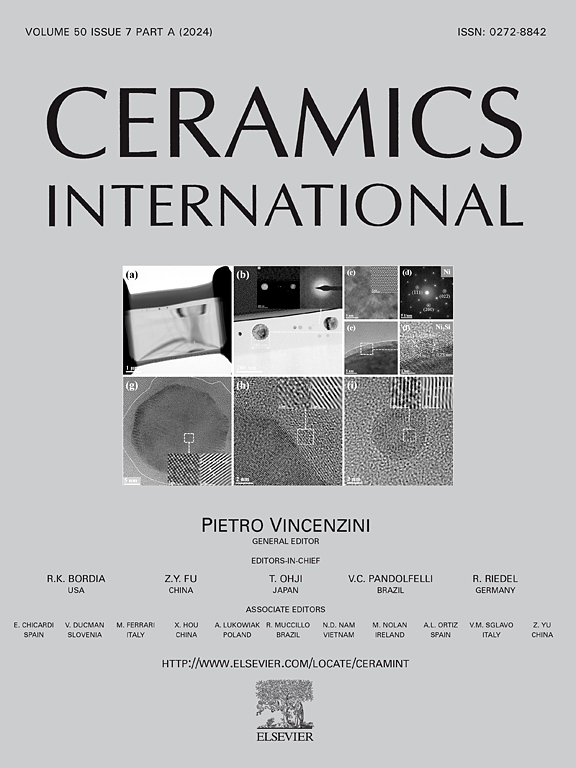Promising excitation-responsive phosphors CaxMgSi2Ox+5: Eu2+, Dy3+ with dual-mode luminescent centers for advanced anti-counterfeiting technology
IF 5.1
2区 材料科学
Q1 MATERIALS SCIENCE, CERAMICS
引用次数: 0
Abstract
Multi-mode luminescence typically produces tunable luminescent responses to different excitations. The formation of multi-mode luminescent centers in a single host is a promising research strategy that offers potential applications in the fields of multilayer advanced anti-counterfeiting technology and encryption technology. In this paper, we systematically studied the crystal structure, surface morphology, elemental composition, luminescence and afterglow properties of Cax-0.06MgSi2Ox+5: Eu2+0.01, Dy3+0.05 (x = 1, 1.2, 1.6, 2) long afterglow phosphors. By continuously adjusting the composition of the CaxMgSi2Ox+5 host, dual-mode luminescent centers were successfully constructed within a single silicate host in Cax-0.06MgSi2Ox+5: Eu2+0.01, Dy3+0.05 (x = 1.2 or 1.6) samples. These dual-mode luminescence phosphors exhibit distinct patterns of changes in the excitation spectra, while still overlapping in certain energy regions, which belongs to the excitation-responsive photoluminescence characteristic. The dynamic variations in luminescence colors of the static materials from near-white to blue light (x = 1.2) and from near-white to light yellow-green light (x = 1.6) were achieved in by excitation wavelength modulation. Their potential applications in the field of multilayered advanced anti-counterfeiting technology were demonstrated by constructing complex patterns. The afterglow emissions of the samples with x = 1 and 1.2 demonstrate a color transformation property over time, which may facilitate further exploration of their applications in information encryption. Additionally, an in-depth study of the electronic structures of the hosts Ca2MgSi2O7 and CaMgSi2O6, along with the doped luminescent center Eu and the co-doped activator Dy, has been systematically investigated using first-principles calculations, which elucidates the reasons for the differences in photoluminescence and afterglow properties between the two crystal phases Ca2MgSi2O7: Eu2+, Dy3+ and CaMgSi2O6: Eu2+, Dy3+. These results are of great value and significance for the research on designing multi-mode luminescence centers with color-controllable properties in a single host.
求助全文
约1分钟内获得全文
求助全文
来源期刊

Ceramics International
工程技术-材料科学:硅酸盐
CiteScore
9.40
自引率
15.40%
发文量
4558
审稿时长
25 days
期刊介绍:
Ceramics International covers the science of advanced ceramic materials. The journal encourages contributions that demonstrate how an understanding of the basic chemical and physical phenomena may direct materials design and stimulate ideas for new or improved processing techniques, in order to obtain materials with desired structural features and properties.
Ceramics International covers oxide and non-oxide ceramics, functional glasses, glass ceramics, amorphous inorganic non-metallic materials (and their combinations with metal and organic materials), in the form of particulates, dense or porous bodies, thin/thick films and laminated, graded and composite structures. Process related topics such as ceramic-ceramic joints or joining ceramics with dissimilar materials, as well as surface finishing and conditioning are also covered. Besides traditional processing techniques, manufacturing routes of interest include innovative procedures benefiting from externally applied stresses, electromagnetic fields and energetic beams, as well as top-down and self-assembly nanotechnology approaches. In addition, the journal welcomes submissions on bio-inspired and bio-enabled materials designs, experimentally validated multi scale modelling and simulation for materials design, and the use of the most advanced chemical and physical characterization techniques of structure, properties and behaviour.
Technologically relevant low-dimensional systems are a particular focus of Ceramics International. These include 0, 1 and 2-D nanomaterials (also covering CNTs, graphene and related materials, and diamond-like carbons), their nanocomposites, as well as nano-hybrids and hierarchical multifunctional nanostructures that might integrate molecular, biological and electronic components.
 求助内容:
求助内容: 应助结果提醒方式:
应助结果提醒方式:


